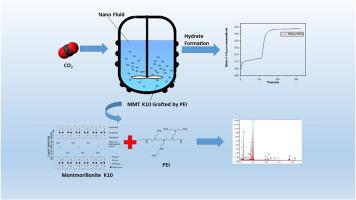当前位置:
X-MOL 学术
›
Gas Sci. Eng.
›
论文详情
Our official English website, www.x-mol.net, welcomes your feedback! (Note: you will need to create a separate account there.)
CO2 capture through gas hydrate formation in the presence of polyethyleneimine-surface-grafted clay
Gas Science and Engineering ( IF 5.285 ) Pub Date : 2024-03-21 , DOI: 10.1016/j.jgsce.2024.205287 Mahsa Jafari Khamirani , Mohsen Mohammadi , Mohammad Dinari , Mohammad Reza Ehsani , Mohammad Shahbazian , Hamid Ganji
Gas Science and Engineering ( IF 5.285 ) Pub Date : 2024-03-21 , DOI: 10.1016/j.jgsce.2024.205287 Mahsa Jafari Khamirani , Mohsen Mohammadi , Mohammad Dinari , Mohammad Reza Ehsani , Mohammad Shahbazian , Hamid Ganji

|
CO capture through gas hydrate formation was performed using a stirring-type vessel in the presence of nanoclay and polyethyleneimine-grafted nanoclay. First, the grafting process was implemented via the wet impregnation method. The nanoparticles were characterized using FT-IR, FESEM, EDS, BET, XRD, TGA, Zeta potential, and DLS analyses. The characterization analyses confirmed surface-grafting of the nanoclay. Then, the hydrate formation experiments were implemented at three various nanoparticle loadings (200, 400, and 500 ppm). Water-to-hydrate conversion, CO gas consumption, apparent rate constant, and hydrate storage capacity were obtained and compared. Prior to conducting the CO hydrate formation experiments in the presence of nanoparticles, the rocking-type and stirring-type vessels were compared to evaluate the hydrate formation rate (using pure water). Stirring-type vessel exhibited higher hydrate formation rates than rocking-type vessel along with improved gas storage performance which resulted in a 22.4% increase in CO consumption. Thus, the effect of additives was examined using the stirring-type vessel. Surface-grafted nanoclay led to higher CO consumption compared to nanoclay at all concentrations. Using 500 ppm of modified nanoclay, grafted by 50 mass% polyethyleneimine (PEI) solution as additive, the maximum enhancement of CO consumption in the hydrate phase in comparison with pure water was obtained, along with the greatest water to hydrate conversion value (39.67). This study introduces a new technique by modifying nanoclay with PEI to improve CO storage in gas hydrate phase, presenting potential advancements in gas storage technology.
中文翻译:

在聚乙烯亚胺表面接枝粘土存在下通过形成天然气水合物捕获二氧化碳
在纳米粘土和聚乙烯亚胺接枝纳米粘土存在下,使用搅拌型容器通过气体水合物形成捕获二氧化碳。首先,通过湿浸渍法进行接枝过程。使用 FT-IR、FESEM、EDS、BET、XRD、TGA、Zeta 电位和 DLS 分析对纳米颗粒进行表征。表征分析证实了纳米粘土的表面接枝。然后,在三种不同的纳米粒子负载量(200、400 和 500 ppm)下进行水合物形成实验。获得并比较了水-水合物转化率、CO气体消耗量、表观速率常数和水合物储存容量。在纳米粒子存在下进行 CO 水合物形成实验之前,比较摇摆型和搅拌型容器以评估水合物形成速率(使用纯水)。搅拌型容器比摇摆型容器表现出更高的水合物形成率,并且气体储存性能得到改善,导致 CO 消耗增加 22.4%。因此,使用搅拌型容器检查添加剂的效果。与纳米粘土相比,表面接枝纳米粘土在所有浓度下都会导致更高的二氧化碳消耗。使用500 ppm的改性纳米粘土,接枝50质量%的聚乙烯亚胺(PEI)溶液作为添加剂,与纯水相比,获得了水合物相中CO消耗的最大提高,以及最大的水至水合物转化值(39.67) 。这项研究引入了一种新技术,通过用 PEI 改性纳米粘土来改善二氧化碳在天然气水合物相中的储存,展示了气体储存技术的潜在进步。
更新日期:2024-03-21
中文翻译:

在聚乙烯亚胺表面接枝粘土存在下通过形成天然气水合物捕获二氧化碳
在纳米粘土和聚乙烯亚胺接枝纳米粘土存在下,使用搅拌型容器通过气体水合物形成捕获二氧化碳。首先,通过湿浸渍法进行接枝过程。使用 FT-IR、FESEM、EDS、BET、XRD、TGA、Zeta 电位和 DLS 分析对纳米颗粒进行表征。表征分析证实了纳米粘土的表面接枝。然后,在三种不同的纳米粒子负载量(200、400 和 500 ppm)下进行水合物形成实验。获得并比较了水-水合物转化率、CO气体消耗量、表观速率常数和水合物储存容量。在纳米粒子存在下进行 CO 水合物形成实验之前,比较摇摆型和搅拌型容器以评估水合物形成速率(使用纯水)。搅拌型容器比摇摆型容器表现出更高的水合物形成率,并且气体储存性能得到改善,导致 CO 消耗增加 22.4%。因此,使用搅拌型容器检查添加剂的效果。与纳米粘土相比,表面接枝纳米粘土在所有浓度下都会导致更高的二氧化碳消耗。使用500 ppm的改性纳米粘土,接枝50质量%的聚乙烯亚胺(PEI)溶液作为添加剂,与纯水相比,获得了水合物相中CO消耗的最大提高,以及最大的水至水合物转化值(39.67) 。这项研究引入了一种新技术,通过用 PEI 改性纳米粘土来改善二氧化碳在天然气水合物相中的储存,展示了气体储存技术的潜在进步。



























 京公网安备 11010802027423号
京公网安备 11010802027423号